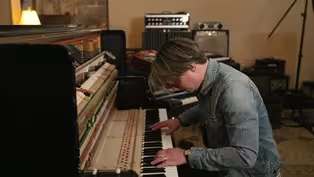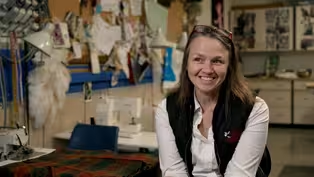
A’ja Nauden
Clip: Season 16 Episode 9 | 8m 52sVideo has Closed Captions
A’ja Nauden paints with meaning in rural Minnesota.
A’ja Nauden paints with meaning in rural Minnesota.
Problems playing video? | Closed Captioning Feedback
Problems playing video? | Closed Captioning Feedback
Postcards is a local public television program presented by Pioneer PBS
Production sponsorship is provided by contributions from the voters of Minnesota through a legislative appropriation from the Arts and Cultural Heritage Fund, Explore Alexandria Tourism, Shalom Hill Farm, Margaret A. Cargil Foundation, 96.7kram and viewers like you.

A’ja Nauden
Clip: Season 16 Episode 9 | 8m 52sVideo has Closed Captions
A’ja Nauden paints with meaning in rural Minnesota.
Problems playing video? | Closed Captioning Feedback
How to Watch Postcards
Postcards is available to stream on pbs.org and the free PBS App, available on iPhone, Apple TV, Android TV, Android smartphones, Amazon Fire TV, Amazon Fire Tablet, Roku, Samsung Smart TV, and Vizio.
Providing Support for PBS.org
Learn Moreabout PBS online sponsorship(paint burbling) (upbeat music) - Hey, my name is A'ja Marie Nauden.
I am an artist and a painter.
I dabble in different mediums, so, acrylic, spray paint, and texture paint.
Look at me go.
I had been to an art museum and there was just this one line, this one red line on a white canvas.
And I was like, "Bro, this painting is selling for like 13 K. It's just a line, like, what is this?"
And one of the curators was like, "No, that's more than just the line."
Like, "That's her story, that's her life."
And, as I'm reading the description, I'm like, "Wow."
Just one line can mean so much, and that's how I kind of took my art and was inspired to create abstract art.
I do abstract art a lot, just because I feel like it has no boundaries.
I make sure through my art that there were no boundaries.
- [Interviewer] Let's start with your life.
- Yes, ma'am.
So, I grew up on the south side of Chicago, on the 115th and Pulaski.
Growing up was hard for me.
It was kind of like a rough childhood growing up.
(brush clinking) Our parents were around, and they were very supportive, but they were having their own battles and struggles too.
When I got to kindergarten, that's when we moved from the inner city to the south suburbs, 'cause my parents didn't think we were gonna make it.
(soft music) When I was in kindergarten, I entered my first art show, and I won.
As I started growing up and realized what my skills were, I just dove into 'em.
I used to sell little drawings and paintings when I was like 10 or 12, but people were very, like, shocked.
I did sports my entire life, so I ran track, and I did volleyball, I did basketball, soccer.
They saw me as an athlete, not an artist.
So I struggled with knowing how to be an artist and be an athlete all at the same time instead of just picking one or the other.
So I took a lot of art classes, but I never felt comfortable in them because I felt I'm not an artist.
And I kept denying, "I'm not an artist, I'm not a real one."
Like, I'm no Picasso or I'm no Van Gogh, you know?
I never felt like all of my work was real until I kind of got to college.
I made a piece for one of my roommates, her dad.
He bought it for his birthday and I thought that was super cool.
And something in me was like, "No, you can do this."
So my experience moving from Chicago to Minnesota was tough.
I never thought in a million years this is where I would move.
I ended up working in a hospital that... You know, it was nice at first, but I just knew that's not why I moved here.
And I started to open up to people more and here I am today, and it feels good now.
- [Interviewer] Oh, okay.
Tell me about the painting behind you.
What does that mean?
- Hold on, I gotta look at it again.
(interviewer chuckling) Okay, yeah.
So, that painting was kind of one of the first ones I did when I got here to Minnesota.
And to me, it expressed my confusion, of whether me really liking it here or me really hating it here.
And with the colors that I chose, brown is, for now, one of my favorite colors.
And I feel like it has become my staple, in who I am and my own representation of myself, me being a little brown girl.
(A'ja chuckling) And, I just really just used my hands.
I didn't use any paintbrushes for that.
I used my hands 'cause I really wanted it to be authentic.
And with my hands, I was like, "Well, what story do I want to tell?"
I want to tell my story of how I started.
And when you do look at it, it's like you can see a whole bunch of things, but if you look closely, you can see flowers, like, where I did my thumbprints.
You can see different images of however your eyes see.
So to me, when people look at that painting, they see me.
So, this is one of my paintings.
I call this one "The Golden Child."
So these are my hand prints, and each one represents my past, my present, and my future.
A'ja's corner.
I made this one here in Minnesota.
This is probably the most perfect representation of how I feel on the inside.
(A'ja chuckling) And then this is another one of my paintings.
I call it "Smack Talk."
Me and my sister made this one on our little sister-date.
This one, I made in Chicago.
I think this one is like one of my favorites.
It's called "Dancing Soul."
And, my, oh, it's upside down.
(A'ja chuckling) - [Interviewer] Do you wanna talk about your love for dancing at all?
- Oh, sure, I'll take it a little bit.
(A'ja laughing) So, I was a little dancer back in Chicago.
(slow inspiring music) I found it as a passion though, like, it really helped me express myself in a different way too.
Like, I learned a lot of new things, not even just like physically, but emotionally and spiritually.
I felt like I got to express myself in a way where not a lot of people really see it as like appropriate, but it made me feel good as a woman.
It really did.
It made me feel like dancing is a part of who I am.
To me, it was art.
I felt like even though it may not be on a paintbrush or a canvas, it felt like a real art.
It felt like this is something I can express myself with and there's no rules.
(water rushing) I think... Not "I think," no.
I know, art has really opened me to a lot of avenues, where it has allowed me to be comfortable in who I am.
I never was confident or comfortable.
I always felt like I had to be somebody else or I had to be like somebody else to feel accepted.
So with art, you can do what you want.
Like, there is no rules.
Like, you can, if I wanna splatter on the canvas, I can just, boop, and that's it.
Like, I don't have to add anything else if I don't want to.
And to me, art is fun, it's not hard.
It's not hard as people make it seem.
You know, you don't have to be anybody spectacular to create art, you could just be normal.
My advice to people out there in the world, take the chance, you'll never know what happened.
And if it happens, it happens.
And if it doesn't, it was never meant to be, so... - [Interviewer] Yeah.
(slow inspiring music continues)
Video has Closed Captions
Clip: S16 Ep9 | 10m 18s | Jacob Pavek explores his passion as a composer in St. Paul. (10m 18s)
Sheila Tabaka, Jacob Pavek, A’ja Nauden
Preview: S16 Ep9 | 40s | Kilt-maker Sheila Tabaka; composer Jacob Pavek; and painter A’ja Nauden (40s)
Video has Closed Captions
Clip: S16 Ep9 | 10m 11s | Sheila Tabaka, of Marshall, tries to preserve the endangered craft of kilt-making. (10m 11s)
Providing Support for PBS.org
Learn Moreabout PBS online sponsorshipSupport for PBS provided by:
Postcards is a local public television program presented by Pioneer PBS
Production sponsorship is provided by contributions from the voters of Minnesota through a legislative appropriation from the Arts and Cultural Heritage Fund, Explore Alexandria Tourism, Shalom Hill Farm, Margaret A. Cargil Foundation, 96.7kram and viewers like you.
























